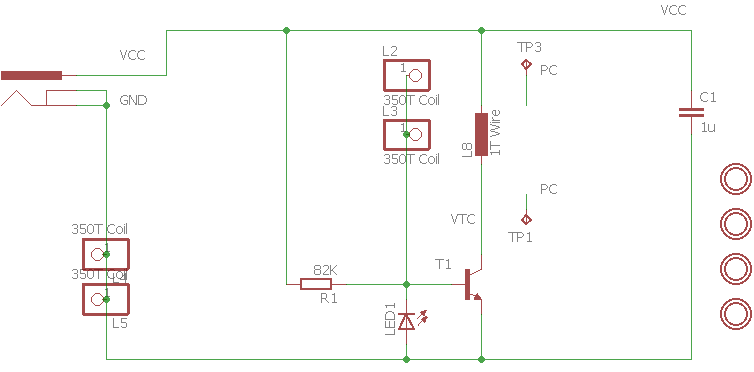Tesla's transformer with printed coils, soldered three components - and ready

The use of printed coils reduces the complexity of manufacturing electronic devices. If they are made for sale, such as, for example, VHF-IP-2 blocks or RFIDs, it is a matter of cost, if it is convenience for yourself. So the proposed Tesla transformer will not have to be wound. The main thing is to wait for the board to arrive, after which the assembly will take a couple of minutes. You will need: a transistor (about which one is better - further), an 82 kΩ resistor and a LED.
... It all started with the fact that the author decided to assemble this design . But its complexity seemed redundant to him, and he decided to simplify it so that there was no place to further simplify.
The device works at a supply voltage of 10 to 35 V. The author suggests to power it either through a boost converter from a sufficiently powerful PSU with a USB output, or directly from a notebook PSU. Of course, the second is more convenient.
Experimenting, the author developed four board options:
')
- practically idle, the author decided to sell the boards as souvenirs, they are useless for practical use
- working, 100 turns, with no visible discharges in the air
- working better, 160 turns, there are still no visible discharges in the air (in fact, you can get small, read on)
- 150x150 mm boards, not yet arrived, 240 turns, they will look like this:

The author ordered the motherboards at JLCPCB, they are quite complicated to manufacture, LUT might not work.
Scheme:

The Eagle script that calculates printed coils with the number of turns over 100. Or you can overcome the 100-turn restriction of the script of the same purpose already in Eagle by editing it manually:
dlgCell(4, 1) dlgLabel("Tur&ns"); // number of turns (Wound) dlgCell(4, 2) dlgRealEdit(n, 1.0, 350.0); Board version 2 works:
The results of experiments with different transistors on the third version of the board:
Transistor FZT851 when powered from 36 V fails immediately. When the supply voltage drops to 12 V and without the LED in the bias circuit, it behaves as follows:
- no heating
- current consumption 0,017 A
- neonka burns at a distance of 10-20 mm from the board
- no visible discharges in the air
- If you touch the board, the current through the transistor increases dramatically, and it fails.
If you place a red LED in the bias circuit in accordance with the scheme, the current consumption increases to 0.2 A, the neon glows at a distance of 30 mm from the board, at its outputs you can get small visible discharges in the air. But when you touch the board, the sharply increasing current consumption still disables the transistor.
With a BD243 transistor at 36 V, the results are the same as with FZT851 at 12 V.
If you reduce the supply voltage to 5-6 V, you can still get a weak glow neonok.
The best results were obtained with a 2N3055 transistor. The author did not select it on purpose, he was just at hand. With 25 V and a red LED in the bias circuit (for some reason blue on the video), you can get quite noticeable discharges in the air at the terminals of the neon, but if you remove it, the transformer works without such discharges.
Source: https://habr.com/ru/post/448828/
All Articles